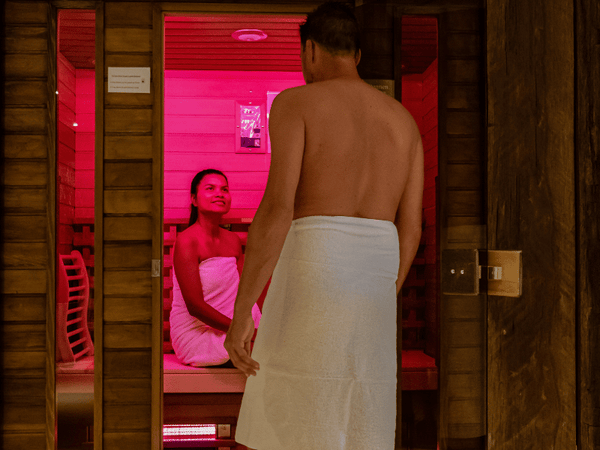
What Are The Benefits Of Infrared Sauna
In recent years, infrared saunas have become a popular wellness trend, known for their numerous health benefits. In contrast to conventional saunas, which heat the air around you, infrared saunas employ light that penetrates your skin to provide direct bodily warmth. This method of heat therapy is said to provide a myriad of health advantages, from detoxification to pain relief.
In this comprehensive guide, we will delve deep into the world of infrared saunas, exploring their potential, the potential benefits of infrared sauna use, how they work, and how they compare to traditional saunas. Whether you're a wellness enthusiast or someone looking for natural ways to improve your health, this article will provide you with valuable insights into the potential benefits of infrared sauna use.
Understanding Infrared Saunas
Infrared saunas are a type of sauna that uses infrared light to create heat. Infrared saunas employ infrared lamps to heat your body directly without warming the air around you, in contrast to regular saunas that heat the air around you. This direct heating method allows for a more comfortable experience, as the temperatures in infrared saunas are usually lower than those in traditional saunas.
Types of Infrared Saunas

There are three main types of infrared saunas, categorized based on the wavelength of the infrared light they emit:
1. Near-Infrared Saunas: These saunas emit wavelengths closest to the visible light spectrum. Infrared waves are believed to be effective for wound healing and skin rejuvenation.
2. Mid-Infrared Saunas: These emit longer wavelengths that penetrate deeper into the body's soft tissue. They are often used for chronic pain management, stress relief, and inflammation reduction.
3. Far-Infrared Saunas: These emit the longest wavelengths, which are best for deep tissue warming and detoxification.
How Infrared Saunas Work

The infrared light emitted by infrared heaters in infrared saunas is absorbed by the skin's surface and then transformed into heat. This heat penetrates the body, raising the core temperature and inducing a deep sweat at a cellular level. Infrared saunas' heat is gentle, making it accessible for people who might find the intense heat of traditional saunas uncomfortable.
The science behind infrared saunas is based on the principle of radiant heat. This means the heat is directly transferred from a warm element or warmed air (in this case, the two infrared sauna treatment heaters) to a cooler body (the person sitting in the infrared sauna treatment itself) without the need for the surrounding air to be heated.
Health Benefits of Infrared Saunas
Infrared saunas offer a wide range of health benefits, supported by both anecdotal evidence and scientific research. Here are some of the most notable advantages of infrared saunas:
Detoxification

One of the primary benefits of infrared saunas is their ability to reduce oxidative stress and help the body detoxify. By inducing deep sweating, infrared saunas can aid in the elimination of toxins, such as heavy metals and environmental pollutants, that are absorbed through the skin and ingested through food and water.
Relaxation and Stress Reduction

Infrared saunas are known for their calming effects. The gentle warmth of the infrared heat helps to maintain blood pressure relax muscles and relieve tension throughout the body. This relaxation response can also help reduce stress levels and promote a sense of well-being.
Pain Relief

Infrared saunas can be effective in alleviating various types of chronic pain,, including joint pain, muscle soreness, and arthritis pain. The deep penetrating heat of traditional infrared sauna treatments also helps to increase blood flow and circulation and reduce inflammation, providing natural pain relief.
Skin Health

Regular use of infrared saunas can improve your skin tone and health by increasing circulation and promoting the elimination of toxins. This can result in clearer, softer, and healthier-looking skin. Infrared saunas may improve skin tone and also help with conditions such as acne, eczema, and psoriasis.
Weight Loss

While infrared saunas are not a replacement for a healthy diet and regular exercise, research suggests they can complement weight loss efforts. The heat generated by the infrared while using a sauna for treatment increases heart rate and metabolism, similar to the effects of moderate exercise, which can aid in burning calories.
Heart Health

Infrared saunas may have cardiovascular health benefits. The heat-induced increase in heart rate and in blood flow and circulation is similar to the effects of light to moderate exercise, which can be beneficial for heart health.
Immune System Boost
Regular use of far infrared saunas can strengthen the immune system. The heat stress from the infrared sauna benefits and traditional sauna use can stimulate the production of white blood cells, which help fight off infections and diseases.
Red Light Therapy: A Complementary Treatment
While infrared saunas are effective in their own right, they can be complemented by another innovative treatment known as Red Light Therapy (RLT). Red light treatment, sometimes referred to as photobiomodulation (PBM) or low-level laser therapy (LLLT), uses particular red and near-infrared light wavelengths to encourage the body's healing cell regeneration and rejuvenation.
How Red Light Therapy Works

Red Light Therapy devices emit red and near-infrared light, which penetrates the skin to various depths high temperatures. This light energy is absorbed by the cells, stimulating the production of adenosine triphosphate (ATP), the energy currency of the cell. This process leads to various cellular and physiological effects, including:
-
Enhanced Cellular Energy: By increasing ATP production, RLT helps cells function more efficiently, promoting healing and regeneration.
-
Reduced Inflammation: RLT has anti-inflammatory properties, which can help reduce swelling and pain in various conditions.
-
Increased Collagen Production: The therapy stimulates collagen synthesis, which can improve skin elasticity, reduce wrinkles, and speed up wound healing.
Benefits of Combining Red Light Therapy with Infrared Sauna
Combining Red Light Therapy with infrared sauna therapy sessions can enhance the overall wellness experience and provide additional health benefits:
-
Synergistic Effects: The combination of infrared heat and red light can enhance circulation, detoxification, and cellular energy production.
-
Skin Rejuvenation: Both treatments promote skin health, and using them together can amplify the effects on skin clarity, texture, and tone.
-
Pain Relief: Infrared saunas and RLT both offer pain-relieving benefits. Using them together can provide more comprehensive relief for chronic pain and inflammation.
Incorporating Red Light Therapy into Your Routine
To incorporate Red Light Therapy into your wellness routine, consider the following tips:
-
Consult a Professional: See a healthcare provider before beginning RLT, particularly if you have any underlying medical issues..
-
Choose the Right Device: Look for a high-quality RLT device that emits the appropriate wavelengths of light (typically around 660 nm for red light and 850 nm for near-infrared light).
-
Follow a Consistent Schedule: Consistency is key with RLT. Aim for regular sessions, following the manufacturer's guidelines for duration and frequency.
Comparing Infrared Saunas to Traditional Saunas
When it comes to choosing a sauna, it's essential to understand the differences between infrared saunas and traditional saunas. Both types offer relaxation and health benefits, but they operate in distinct ways and have unique features.
Temperature and Humidity
-
Infrared Saunas: These saunas typically operate at lower temperatures, usually between 120°F and 150°F (49°C and 65°C). The lower heat makes it more comfortable for people who can't tolerate the high heat of traditional saunas. Infrared saunas have low humidity levels.
-
Traditional Saunas: Traditional saunas, including Finnish saunas and steam rooms, operate at higher temperatures, usually between 150°F and 195°F (65°C and 90°C). They also have higher humidity levels, especially steam rooms.
Heating Method
-
Infrared Saunas: Infrared light is emitted by infrared heaters in infrared saunas, directly heating the body without raising the air temperature too much.
-
Traditional Saunas: Traditional saunas use a stove or heater to heat the air, which then warms the body indirectly through convection and conduction.
Health Benefits
-
Infrared Saunas: The deep penetration of infrared heat is believed to offer unique health benefits, such as enhanced detoxification, deeper tissue penetration for muscle relaxation, and improved circulation.
-
Traditional Saunas: The high heat and humidity of traditional saunas can be beneficial for respiratory health, increased sweating for toxin elimination, and muscle relaxation.
Experience and Comfort
-
Infrared Saunas: Many users find the experience of an infrared sauna to be gentler and more comfortable due to the lower temperatures and direct heating method.
-
Traditional Saunas: The intense heat and humidity of traditional saunas provide a more intense experience, which some users prefer for its invigorating effects.
Pros and Cons
- Infrared Saunas:
-
Pros: Lower temperatures, deeper heat penetration, potentially greater detoxification.
-
Cons: Less intense heat may not provide the same level of sweating or cardiovascular benefits as traditional saunas.
- Traditional Saunas:
-
Pros: Higher temperatures, increased sweating, potential respiratory benefits.
-
Cons: The intense heat may not be suitable for everyone, especially those with certain health conditions.
Safety and Precautions
While infrared saunas offer numerous health benefits, it's essential to use them safely and be aware of certain precautions to avoid any potential risks.
General Safety Guidelines
-
Hydration: Ensure you're well-hydrated before entering the sauna, and drink plenty of water before, during, and after your session to replace fluids lost through sweating.
-
Time Limit: Limit your sauna sessions to 15-20 minutes, especially when you're new to using an infrared sauna. As you become accustomed to the heat, you can gradually increase the duration, but it's generally advised not to exceed 40 minutes.
-
Temperature: Start with a lower temperature and gradually increase it as your body adapts. Avoid overheating, which can lead to dehydration and heat exhaustion.
-
Cool Down: Allow your body to cool down gradually after your sauna session. Take a lukewarm shower or sit in a cool area for a few minutes before returning to your normal activities.
Contraindications
Certain individuals should exercise caution or avoid using infrared saunas altogether:
-
Pregnant Women: Pregnant women should consult their healthcare provider before using an infrared sauna, as excessive heat can be harmful to the fetus.
-
Individuals with Heart Conditions: Those with cardiovascular issues, such as high blood pressure or heart disease, should seek medical advice before using a sauna.
-
People with Skin Conditions: If you have a skin condition, consult your dermatologist before using an infrared sauna, as the heat may exacerbate some conditions.
-
Children: Children's bodies are less able to regulate temperature, so they should only use saunas under close supervision and for shorter durations.
Tips for a Safe Sauna Experience
-
Listen to Your Body: At any time, if you feel lightheaded, queasy, or uncomfortable, get out of the sauna right away and cool down.
-
Avoid Alcohol: Don't use the sauna if you've consumed alcohol, as it can increase the risk of dehydration and dizziness.
-
Remove Jewelry: Metal objects can become hot in the sauna and cause burns, so it's best to remove jewelry before entering.
How to Use an Infrared Sauna
To maximize the benefits of your infrared sauna experience, it's important to follow some best practices. Here's a step-by-step guide on how to use an infrared sauna effectively:
Preparing for Your Sauna Session
1. Hydrate: Drink plenty of water before your sauna session to ensure you're well-hydrated.
2. Wear Comfortable Clothing: Wear loose, breathable clothing or a towel. Some people prefer to use the sauna in the nude for maximum skin exposure to the infrared rays.
3. Set the Temperature: Preheat the sauna to your desired temperature. A good starting point for dry heat is between 120°F and 140°F (49°C and 60°C).
4. Timing: Plan to spend about 15-30 minutes in the first sauna bathing together. You can adjust the duration of sauna bathing based on your comfort level and experience.
During Your Sauna Session
1. Relax: Sit or lie down comfortably and try to relax your body and mind. You can meditate, listen to calming music, or simply enjoy the quiet.
2. Stay Hydrated: Drink water throughout your session to stay hydrated. Keep a water bottle within reach.
3. Listen to Your Body: Pay attention to how you feel during the session. If you start to feel dizzy, lightheaded, or uncomfortable, it's time to exit the sauna.
After Your Sauna Session
1. Cool Down: Allow your body to cool down gradually. You can take a lukewarm shower or sit in a cool area for a few minutes.
2. Rehydrate: Drink more water to replenish fluids lost through sweating.
3. Rest: Take some time to rest and allow your body to recover from the heat exposure.
Tips for Enhancing Your Sauna Experience
-
Use Essential Oils: Add a few drops of your favorite essential oil to a diffuser or a damp cloth for a relaxing aroma.
-
Incorporate Meditation or Breathing Exercises: Practice deep breathing or meditation to enhance the relaxation benefits of your sauna session.
-
Try Chromotherapy: Some infrared saunas come with chromotherapy (color therapy) lights. Experiment with different colors to see if they enhance your experience.
Choosing the Right Infrared Sauna
Selecting the right infrared sauna can be a significant investment in your health and wellness. Here are some key factors to consider when making your choice far infrared sauna:
Size and Capacity
-
Personal Use: If you plan to use the sauna alone, a one- or two-person sauna might be sufficient.
-
Family or Group Use: For families or those who plan to share the sauna with friends, larger models that accommodate three or more people may be more appropriate.
Types of Infrared Heaters
-
Carbon Fiber Heaters: These provide even heat distribution and are energy-efficient. They are known for their long lifespan and low EMF (electromagnetic field) levels.
-
Ceramic Heaters: These are known for their high infrared output and quick heating time. However, they may produce higher EMF levels compared to carbon fiber heaters.
Material and Construction
-
Wood Type: Look for saunas made from non-toxic, hypoallergenic woods such as Canadian hemlock or cedar. These woods are resistant to moisture and have natural insulating properties.
-
Build Quality: Ensure the sauna is well-constructed with sturdy materials and good insulation to retain heat effectively.
Safety Features
-
Low EMF Levels: Choose a sauna with low EMF levels to minimize exposure to electromagnetic fields.
-
Temperature Control: Look for a sauna with an accurate and easy-to-use temperature control system.
-
Timer: A built-in timer can help you keep track of your sauna sessions and prevent overheating.
Additional Features
-
Chromotherapy Lights: Some saunas come with color therapy lights that offer additional relaxation and health benefits.
-
Bluetooth Speakers: If you enjoy listening to music or podcasts while in the sauna, look for a model with built-in speakers and Bluetooth connectivity.
-
Ventilation: Proper ventilation is important for air circulation and comfort during your sauna session.
Warranty and Customer Support
-
Warranty: Check the warranty coverage for the sauna and its components. A good warranty can provide peace of mind and protection for your investment.
-
Customer Support: Consider the manufacturer's reputation for customer service. Good customer support can be valuable if you have questions or issues with your sauna.
FAQs
1. How often should I use an infrared sauna?
The frequency of infrared sauna treatments you use depends on your individual health goals and tolerance. For general wellness, using an infrared sauna 2-3 times a week is a good starting point. If you're using it for specific health concerns, you may benefit from more frequent sessions, but it's important to listen to your body and avoid overdoing it.
2. Can I use an infrared sauna if I'm pregnant?
Pregnant women should consult their healthcare provider before using an infrared sauna. The increased heat and body temperature of a traditional sauna can pose risks during pregnancy, so it's essential to get medical advice tailored to your specific situation.
3. Are there any side effects of using an infrared sauna?
Most people tolerate infrared saunas well, but some may experience mild side effects like dizziness, chronic fatigue syndrome, nausea, or dehydration, especially if they stay in the sauna for too long or don't hydrate properly. It's important to start your sauna culture with shorter sessions and gradually increase the duration as your body adapts.
4. How does an infrared sauna differ from a traditional sauna?
Unlike traditional saunas, which heat the air around you, infrared saunas employ infrared light to directly heat the body. This results in a lower air temperature and a distinct type of heat feeling. This can make infrared saunas more comfortable for some people, especially those who find the high heat of traditional saunas too intense.
5. Can infrared saunas help with weight loss?
While infrared saunas can support weight loss muscle recovery efforts by less body weight and increasing your heart rate and metabolism, they should not be relied upon as the sole method for losing weight. A balanced diet and regular exercise are still essential for effective weight management.
6. Is it safe to use an infrared sauna every day?
Using an infrared sauna therapy or infrared sauna therapy, almost daily is generally safe for most people, but it's important to monitor your body's response and adjust your the sauna therapy usage as needed. If you experience any discomfort or adverse effects, reduce the frequency or duration of your infrared sauna therapy sessions.
7. How long does it take to see results from using an infrared sauna?
The time it takes to see results from using an infrared sauna can vary depending on your health goals and how frequently you use the sauna. Some benefits of sauna use and bathing, like relaxation, reduced pain, and improved circulation, can be felt immediately after using a sauna session, while others, like weight loss or skin improvement, may take several weeks or months of regular sauna bathing and use to become noticeable.
8. Can I use an infrared sauna if I have a medical condition?
If you have a medical condition, it's important to consult with your healthcare provider before using an an infrared sauna session. Some conditions, such as heart disease or skin disorders, may require special precautions or may contraindicate infrared or sauna use or session use altogether.
9. How do I clean and maintain my infrared sauna?
To maintain your infrared sauna, wipe down the interior surfaces with a damp cloth after each use to remove sweat and impurities. Avoid using harsh chemicals, as they can damage the wood and components. Periodically, you can use a mild, natural cleaning solution to deep clean the sauna.
10. Can children use infrared saunas?
Children can use infrared saunas, but they should be supervised by an adult and limit their sessions to shorter durations than adults. It's also important to ensure they stay hydrated and exit the infrared sauna session if they feel uncomfortable at any time.
Conclusion
Infrared saunas have gained considerable attention for their unique approach to wellness and relaxation. Unlike traditional saunas, which heat the air to warm the body, infrared saunas use light to directly heat the body, offering a range of health benefits from improved circulation and detoxification to pain relief and stress reduction. The addition of Red Light Therapy (RLT) to infrared sauna benefits can further enhance these benefits, particularly in areas of skin health and inflammation reduction.
When considering incorporating an infrared sauna therapy into your wellness routine, it’s important to weigh the various types, features, and safety considerations. Choosing the right infrared sauna therapy also involves understanding your personal health goals, the space available, and the specific features that will enhance your own infrared sauna therapy and experience, such as chromotherapy or low EMF levels.
Remember, while the benefits of infrared saunas and heat therapy are numerous, they should complement a holistic approach to health that includes a balanced diet, regular exercise, and adequate sleep. Always consult with a healthcare professional before beginning any new health regimen, especially if you have pre-existing health conditions.
As we continue to seek out ways to support our health and well-being, infrared saunas stand out as a valuable tool in our wellness arsenal. By offering a relaxing way to detoxify, relieve pain chronic fatigue syndrome, improve circulation, high blood pressure and promote overall health, infrared saunas can play for more than a decade a pivotal role in enhancing our quality of life.
We hope this guide has provided you with comprehensive insights into the benefits of infrared saunas and how they can be integrated into your wellness journey. Here's to your health and wellness!
Ready to embark on a transformative journey with infrared saunas? Explore your options, listen to your body, and find the perfect balance for a healthier, happier you.


